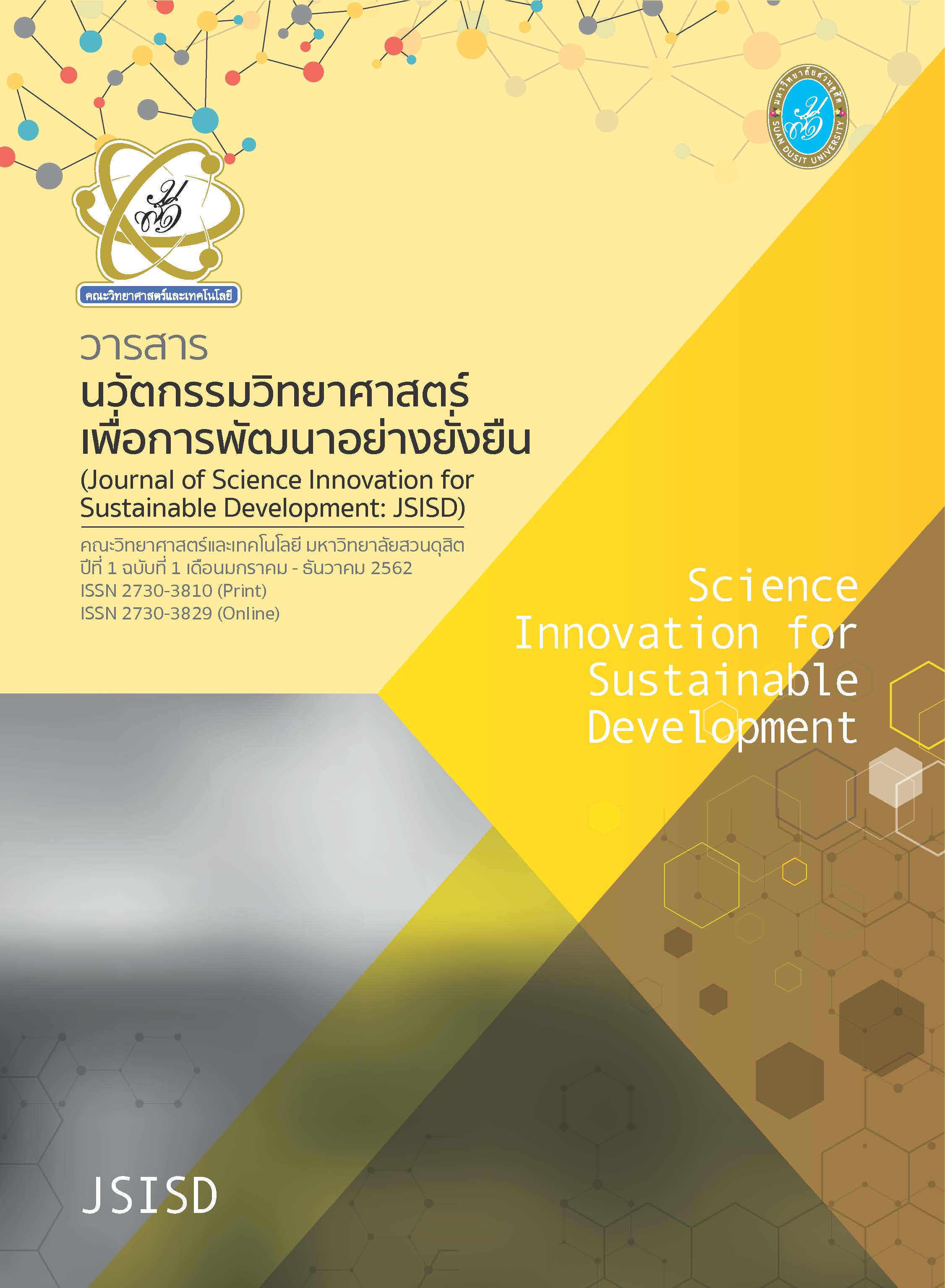การผลิตหน้ากากอนามัยที่มีฤทธิ์ยับยั้งเชื้อแบคทีเรียในระบบทางเดินหายใจด้วยการเติมสารสกัด จากสะระแหน่และใบมันสำปะหลัง ฐิตินาถ สุคนเขตร์*, นัฐชริตา นาวีว่อง, สุจินทรา เอกวัตร์ และ สรัญญา เศวตอัญมณี
Main Article Content
บทคัดย่อ
การวิจัยครั้งนี้มีวัตถุประสงค์เพื่อผลิตหน้ากากอนามัยที่มีฤทธิ์ยับยั้งเชื้อแบคทีเรียในระบบทางเดินหายใจด้วยการเติมสารสกัดเมนทอลจากใบสะระแหน่ และแทนนินจากใบมันสำปะหลัง พบว่า สภาวะที่เหมาะสม
ในการสกัดสารเมนทอล คือ ใช้ใบสะระแหน่ 45 กรัม สกัดด้วยไอน้ำ 30 นาที และสภาวะของการสกัด
สารแทนนิน คือ ใช้ใบมันสำปะหลัง 1 กรัม ต่อเอทานอลเข้มข้นร้อยละ 95 ปริมาตร 20 มิลลิลิตร สกัดเป็นเวลา
4 ชั่วโมง ที่อุณหภูมิห้อง วิเคราะห์สารสกัดเมนทอลและสารสกัดแทนนินด้วยเครื่อง GC-MS และ HPLC ตามลำดับ พบว่า สารที่สกัดได้มีองค์ประกอบเป็นสารเมนทอลและสารแทนนินตามมาตรฐาน ผลการทดสอบสมบัติการยับยั้งเชื้อแบคทีเรีย Klebsiella pneumoniae และ Pseudomonas aeruginosa ซึ่งเป็นเชื้อแบคทีเรียก่อโรคในระบบทางเดินหายใจ พบว่า ปริมาณสารสกัดเมนทอลที่ 15 มิลลิกรัมต่อมิลลิลิตร และปริมาณสารสกัดแทนนินที่ 5 มิลลิกรัมต่อมิลลิลิตร จะยับยั้งเชื้อแบคทีเรียได้ทั้ง 2 ชนิด ที่เวลา 24 ชั่วโมง เมื่อทดสอบการเกิดเชื้อราบนหน้ากากที่สภาวะอุณหภูมิห้อง อุณหภูมิร้อน อุณหภูมิเย็นและในสภาวะที่อับชื้น พบว่า หน้ากากอนามัยที่มีสารสกัดไม่เกิดเชื้อราบนหน้ากากในเวลา 24 ชั่วโมง จากการศึกษาผลความพึงพอใจของผู้ใช้ 20 คน พบว่า ผู้ใช้มีความพึงพอใจต่อหน้ากากอนามัยจากสารสกัดจากพืชธรรมชาติ ไม่แตกต่างจากหน้ากากอนามัยตามท้องตลาด อย่างมีนัยสำคัญ (p=0.05)
Article Details

อนุญาตภายใต้เงื่อนไข Creative Commons Attribution-NonCommercial-NoDerivatives 4.0 International License.
ลิขสิทธิ์ต้นฉบับที่ได้รับการตีพิมพ์ในวารสารนวัตกรรมวิทยาศาสตร์เพื่อการพัฒนาอย่างยั่งยืนถือเป็นกรรมสิทธิ์ของคณะวิทยาศาสตร์และเทคโนโลยี มหาวิทยาลัยสวนดุสิต ห้ามผู้ใดนำข้อความทั้งหมดหรือบางส่วนไปพิมพ์ซ้ำ เว้นแต่จะได้รับอนุญาตอย่างเป็นลายลักษณ์อักษรจากคณะวิทยาศาสตร์และเทคโนโลยี มหาวิทยาลัยสวนดุสิต นอกจากนี้ เนื้อหาที่ปรากฎในบทความเป็นความรับผิดชอบของผู้เขียน ทั้งนี้ไม่รวมความผิดพลาดอันเกิดจากเทคนิคการพิมพ์
เอกสารอ้างอิง
พจมาน ผู้มีสัตย์, ชุลีพร ออมสิน, ประภาพร ยวงสาย, และรุ่งตะวัน ส่องแสง (2551). สมุนไพรที่สามารถยับยั้งเชื้อ Klebsiella pneumoniae ที่สร้างเอนไซม์ Extended-Spectrum Beta-lactamase (ESBL). วารสารก้าวทันโลกวิทยาศาสตร์. 8 (2): 148-153.
พิชญ์ ศุภผล และผู้แต่งคนอื่นๆ. (2554) การผลิตแผ่นหน้ากากอนามัยและแผ่นกรองอากาศ ที่มีฤทธิ์ต้านเชื้อวัณโรคจากสารสกัดจากเปลือกมังคุด /. วิทยาลัยปิโตรเลียมและปิโตรเคมี จุฬาลงกรณ์มหาวิทยาลัย: ม.ป.ท.
รัตนา อินทรานุปกรณ์. (2547). การตรวจสอบและการสกัดแยกสารสำคัญจากสมุนไพร. กรุงเทพฯ: จุฬาลงกรณ์มหาวิทยาลัย.
สมภารธัชธรณ์ ศิโลศรีไช. (2019). การศึกษาพืชสมุนไพรจากใบสะระแหน่. แหล่งข้อมูล: http://gsc.nmc.ac.th/th/ article_details.php?id=2H6EXC. 1 พฤษภาคม, 2560.
สำนักงานกองทุนเงินทดแทน. (2560). รายงานประจำปี 2559 กองทุนเงินทดแทน. แหล่งข้อมูล: https:// www. sso.go.th/wpr/assets/upload/files_storage/sso_th/9bf7acf814f7f4c32db1136fad7fa4ab.pdf.
พฤษภาคม, 2561.
Bottcher, J., & Momks K. (2016). Quantitative determination of gallic acid and tannic acid from gallnut extract. แหล่งข้อมูล: https://files.vogel.de/vogelonline/vogelonline/companyfiles/ 12758.pdf. 1 พฤษภาคม, 2560.
Burana-Osot, J., and others. (2016). Determination of volatile constituents from crude drugs of Phihud Navakot by gas chromatography-mass spectrometry. Thai Bull Pharm Sci. 11(2): 45-60.
Dai, J., and others. (2010). Investigation of various factors for the extraction of peppermint (Mentha piperita L.) leaves. Journal of food Engineering. 96: 540-543.
Desam, N.R., and others. (2017). Chemical constituents, in vitro antibacterial and antifungal activity of Mentha x Piperita L. (peppermint) essential oils. Journal of King Saud University – Science. http://dx.doi.org/10.1016/j.jksus.2017.07.013
Naima, R., and others. (2015). Comparison of the impact of different extraction methods on polyphenols yields and tannins extracted from Moroccan Acacia mollissima barks. Industrial Crops & Products. 70: 245-252.
Naima, R., and others. (2015). Green extraction process of tannins obtained from Moroccan Acacia mollissima barks by microwave: Modeling and optimization of the process using the response surface methodology RSM. Arabian Journal of Chemistry, http://dx.doi.org/10. 1016/j .arabjc. 2015.04.032.
Widsten, P., and others. (2010). Enzymatic surface functionalisation of lignocellulosic materials with tannins for enhancing antibacterial properties. Process Biochemistry. 45: 1072–1081.


